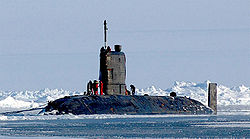Trafalgar class (1981)
|
HMS Tireless at the North Pole
|
||||||||||||||||
|
||||||||||||||||
|
||||||||||||||||
|
||||||||||||||||
|
||||||||||||||||
|
||||||||||||||||
The nuclear-powered attack submarines of the Trafalgar class are since 1982 in the British Royal Navy in service. They were built by Vickers (now BAE Systems ) in Barrow-in-Furness, England. Their home port is the Devonport Naval Base near Plymouth .
The Trafalgar- class boats were ordered in 1978 to complement the Swiftsure- class submarines . Your primary task should be the pursuit and combat of Soviet submarines and warships. After the end of the Cold War , the submarines were increasingly used as escorts for British convoys. In 1999, the HMS Trafalgar was converted for the use of Tomahawk cruise missiles as the first submarine in its class . These were first used during the Afghan war. Two Trafalgar- class submarines were also in service in the Persian Gulf during the 2003 Iraq War . The main task of the submarines, however, continues to be the reconnaissance and escort protection for British warships, especially for the aircraft carriers of the Invincible class .
technology
The submarines are powered by a PWR1 pressurized water reactor. In contrast to the Swiftsure class, which is driven by a conventional propeller, the Trafalgar class has a so-called nozzle ring propeller , which turns much slower at the same speed and is therefore considerably quieter. At the Trafalgar , this drive system was retrofitted later because it was not yet available during the construction of the boat.
The youngest four submarines of the Trafalgar class have been brought up to date with the latest technology since 2001 . The previous Sonar Type 2020 will be exchanged for the highly developed Type 2076 . With this, the submarines are able to locate an object at a distance of over 100 km. A modernization of the drive should further reduce the noise development. The core of the program is the equipment with modern control rooms and communication facilities. The total cost of retrofitting the four submarines is around one billion euros .
As a result of the modernization, the Trafalgar class should be as powerful as the Astute class , which has been in service since 2010. It will replace the seven Trafalgar- class submarines by 2022 . The remaining submarines are to be decommissioned between 2019 and 2022.
units
The class was initially based in Devonport for three decades . The two youngest still active boats have been stationed in Faslane-on-Clyde since 2019 and 2020 respectively .
| Identifier | Surname | Keel laying | Launch | Commissioning | Decommissioning |
|---|---|---|---|---|---|
| S107 | HMS Trafalgar | April 25, 1979 | July 1, 1981 | May 27, 1983 | 4th December 2009 |
| S87 | HMS Turbulent | May 8, 1980 | 1st December 1982 | 1st December 1982 | July 14, 2012 |
| S88 | HMS Tireless | June 6, 1981 | March 17, 1984 | 5th October 1985 | 19th June 2014 |
| S90 | HMS Torbay | 3rd December 1982 | March 8, 1985 | February 7, 1987 | July 14, 2017 |
| S91 | HMS Trenchant | October 28, 1985 | 3rd November 1986 | January 14, 1989 | |
| S92 | HMS talent | May 13, 1986 | April 15, 1988 | May 12, 1990 | |
| S93 | HMS triumph | 2nd February 1987 | February 16, 1991 | October 2, 1991 |
photos
literature
- Ministry of Defense (ed.): The Royal Navy Handbook . Conway Maritime Press, London 2003. ISBN 0-85177-952-2
Web links
Footnotes
- ↑ a b c d Weyers Flotten Taschenbuch 1994/1996, Germany 1995, ISBN 3-7637-4507-6 , page 96 f.
- ↑ La Royal Navy reprend du poil de la bete. September 11, 2017, accessed on September 11, 2017 .
- ^ Nuclear submarine moved to new home on the Clyde. UK Defense Journal, 9th August 2018
- ↑ http://news.bbc.co.uk/2/hi/uk_news/england/devon/8353621.stm
- ↑ HMS Torbay to be decommissioned in Devonport today ( Memento July 14, 2017 in the Internet Archive ), Plymouth Herald July 14, 2017, accessed August 22, 2017



